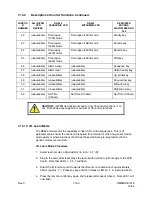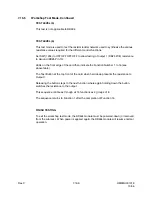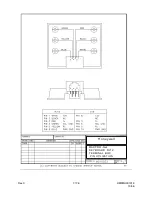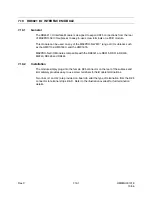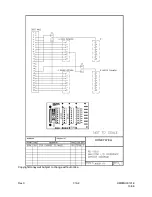
Rev. C
7.17-1
HMXMU001018
10/06
7.17 HEGS5300 Keyboard
7.17.1 Setup
Mode
HEGS5300 (and version 2 and above RD-530 keyboards) are setup using the keyboard
keys. There are 3 user-defined settings. These are:
•
Keyboard ID – valid IDs 1 to 99. (Default = ID 1).
•
Baud Rate – 19K2 or 9600. (Default = 19K2. Data format is fixed at 7 data bits,
1 stop bit, even parity).
•
Joystick speed range – There are 2 ranges of pan/tilt speeds from the analogue
joystick. The default is a range of 5 speeds (0=STOP to 5=Maximum speed). The
alternative is a range of 26. As before 0=STOP, but the speeds generated are from A
(slowest) through to Z (fastest. Speed Z is equivalent to speed 5, in that it is
generated when the joystick is at its maximum pan or tilt position.
To enter SETUP MODE, hold down the <
MENU
> key or the
⇑
key (to the right-hand-
side of the LCD) as the keyboard is powered up.
Note:
When some custom keyboard overlays are fitted
to keyboards, the MENU key may be located in a different
position. Therefore using the
⇑
key next to the LCD is
always a preferred option.
Note
: The
⇑
key option is only available on keyboards
with firmware revisions 2.02 and above.
Once in setup mode, the LCD prompts the user to enter the required information using
the numeric keypad. Pressing the <
ENTER
> key or the
⇓
key moves to the next stage.
Pressing the
⇑
key goes back to the previous setup screen.
When the keyboard ID, baud rate and joystick speed range has been entered, the final
setup stage will store the settings and the joystick reference position. The keyboard
should be flat on the desk when pressing the <
ENTER
> key at this final stage to ensure
the joystick is zeroed. Setup information is stored in non-volatile memory so the settings
will be retained if the keyboard is unplugged.
Summary of Contents for MAXPRO-Net
Page 12: ...Rev C xii HMXMU01018 10 06 Notes ...
Page 20: ...Rev C xx HMXMU01018 10 06 Notes ...
Page 28: ...Rev C 4 2 HMXMU01018 10 06 Notes ...
Page 42: ...Rev C 7 2 HMXMU001018 10 06 Notes ...
Page 46: ...Rev C 7 2 4 HMXMU001018 10 06 Notes ...
Page 52: ...Rev C 7 3 6 HMXMU001018 10 06 Notes ...
Page 56: ...Rev C 7 4 4 HMXMU001018 10 06 Notes ...
Page 62: ...Rev C 7 6 4 HMXMU001018 10 06 Notes ...
Page 72: ...Rev C 7 9 6 HMXMU001018 10 06 Notes ...
Page 105: ...Rev C 7 11 17 HMXMU001018 10 06 ...
Page 106: ...Rev C 7 11 18 HMXMU001018 10 06 ...
Page 107: ...Rev C 7 11 19 HMXMU001018 10 06 ...
Page 108: ...Rev C 7 11 20 HMXMU001018 10 06 ...
Page 109: ...Rev C 7 11 21 HMXMU001018 10 06 ...
Page 110: ...Rev C 7 11 22 HMXMU001018 10 06 ...
Page 111: ...Rev C 7 11 23 HMXMU001018 10 06 ...
Page 112: ...Rev C 7 11 24 HMXMU001018 10 06 ...
Page 125: ...Rev C 7 12 13 HMXMU001018 10 06 ...
Page 126: ...Rev C 7 12 14 HMXMU001018 10 06 ...
Page 127: ...Rev C 7 12 15 HMXMU001018 10 06 ...
Page 128: ...Rev C 7 12 16 HMXMU001018 10 06 ...
Page 129: ...Rev C 7 12 17 HMXMU001018 10 06 ...
Page 130: ...Rev C 7 12 18 HMXMU001018 10 06 NOTES ...
Page 146: ...Rev C 7 15 12 HMXMU001018 10 06 Notes ...
Page 168: ...Rev C 7 19 2 HMXMU001018 10 06 HONEYWELL Copyright Honeywell Subject to change without notice ...
Page 170: ...Rev C 7 20 2 HMXMU001018 10 06 ...
Page 174: ...Rev C 8 4 HMXMU001018 10 06 8 3 PT321 CONNECTIONS ...
Page 175: ...Rev C 8 5 HMXMU001018 10 06 8 3 PT321 CONNECTIONS CONTINUED ...
Page 176: ...Rev C 8 6 HMXMU001018 10 06 8 4 PT323 CONNECTIONS ...
Page 177: ...Rev C 8 7 HMXMU001018 10 06 8 5 PT324 CONNECTIONS ...
Page 178: ...Rev C 8 8 HMXMU001018 10 06 8 6 PT325 CONNECTIONS ...
Page 179: ...Rev C 8 9 HMXMU001018 10 06 8 7 PT327 CONNECTIONS ...
Page 180: ...Rev C 8 10 HMXMU001018 10 06 8 8 RD390 LENS CONTROL EMULATOR CONNECTIONS ...
Page 181: ...Rev C 8 11 HMXMU001018 10 06 8 9 I O MODULE D25 CONNECTIONS ...
Page 182: ...Rev C 8 12 HMXMU001018 10 06 8 9 I O MODULE D25 CONNECTIONS CONTINUED ...
Page 198: ...Rev C 10 2 HMXMU001018 10 06 Notes ...

